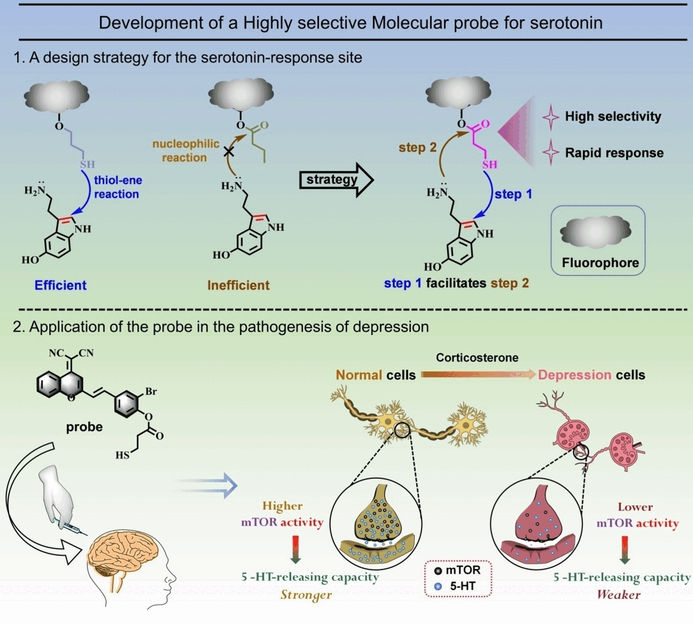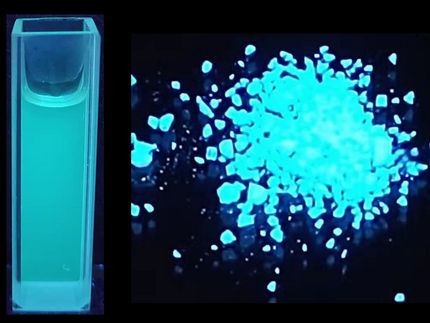Tracking Depression
Molecular probe specifically detects serotonin in fluorescence imaging
serotonin in depression is highly relevant in diagnosis, treatment, and drug development. To better study this area, a Chinese team has now developed a fluorescent probe for imaging processes that is highly sensitive and selective toward serotonin. In the journal Angewandte Chemie, they also introduce the preliminary results obtained from the cell and animal models.

© Wiley-VCH
Depression represents a significant public health problem around the world. Current treatments are insufficient, primarily because it is difficult to determine the mechanism of depression. New studies indicate that depression is not exclusively caused by decreased serotonin levels.
To examine the role of serotonin in depression, a team led by Weiying Lin at Guangxi University (China) wanted to develop a highly selective molecular fluorescent probe. The problem with this is that serotonin’s structure and chemistry closely resemble other biomolecules, such as melatonin and tryptophan. However, precise analyses have revealed subtle differences in reactivity. The team designed a special reactive group (3-mercaptopropionate) that can react very selectively with serotonin via a cascade reaction. They attached this reactive building block to a fluorescent dye (dicyanomethylene-benzopyran derivative).
Attachment of the “appendage” initially switches the probe “off”. If it encounters serotonin, one section reacts first (SH group of the reactive building block binds to a double bond in serotonin, thiol-ene click reaction). Afterward, facilitated by proximity, a second bond is formed (nucleophilic reaction between an amino group in serotonin and a carbonyl group in the reactive building block). As a result, the building block is removed from the fluorescent dye and its fluorescence is switched “on”. The probe selectively and sensitively indicates the presence of serotonin, even inside cells.
The team used the probe to image a neuron cell line that can be made into a model for depression by the administration of corticosterone. It turned out that the serotonin level in the normal and “depressed” cells was nearly equally high. However, the depressive cells were able to expel significantly less serotonin in response to stimulation. Administration of the current antidepressive drugs (serotonin reuptake inhibitors) slightly increased the release.
According to a hypothesis, mTOR, a biomolecule that plays a role in many cellular signaling pathways, could be related to a reduced ability to release serotonin. The team observed that with the mTOR activators, the serotonin release in the depressive cells was significantly increased, while the mTOR inhibitors reduce serotonin release from the normal cells. All results could be confirmed in the neuron and mouse models.
These imaging studies suggest that the serotonin level in the model for depression is not the primary factor. The ability of neurons to release serotonin seems far more critical. This ability correlates strongly with the activity of mTOR, which could point the way to advancement in the treatment of depression.
Original publication
Most read news
Original publication
Lizhou Yue, Huawei Huang, Weiying Lin; "Development of a Fluorescent Probe with High Selectivity based on Thiol‐ene Click Nucleophilic Cascade Reactions for Delving into the Action Mechanism of Serotonin in Depression"; Angewandte Chemie International Edition, 2024-9-5
Organizations

Get the analytics and lab tech industry in your inbox
By submitting this form you agree that LUMITOS AG will send you the newsletter(s) selected above by email. Your data will not be passed on to third parties. Your data will be stored and processed in accordance with our data protection regulations. LUMITOS may contact you by email for the purpose of advertising or market and opinion surveys. You can revoke your consent at any time without giving reasons to LUMITOS AG, Ernst-Augustin-Str. 2, 12489 Berlin, Germany or by e-mail at revoke@lumitos.com with effect for the future. In addition, each email contains a link to unsubscribe from the corresponding newsletter.


























































